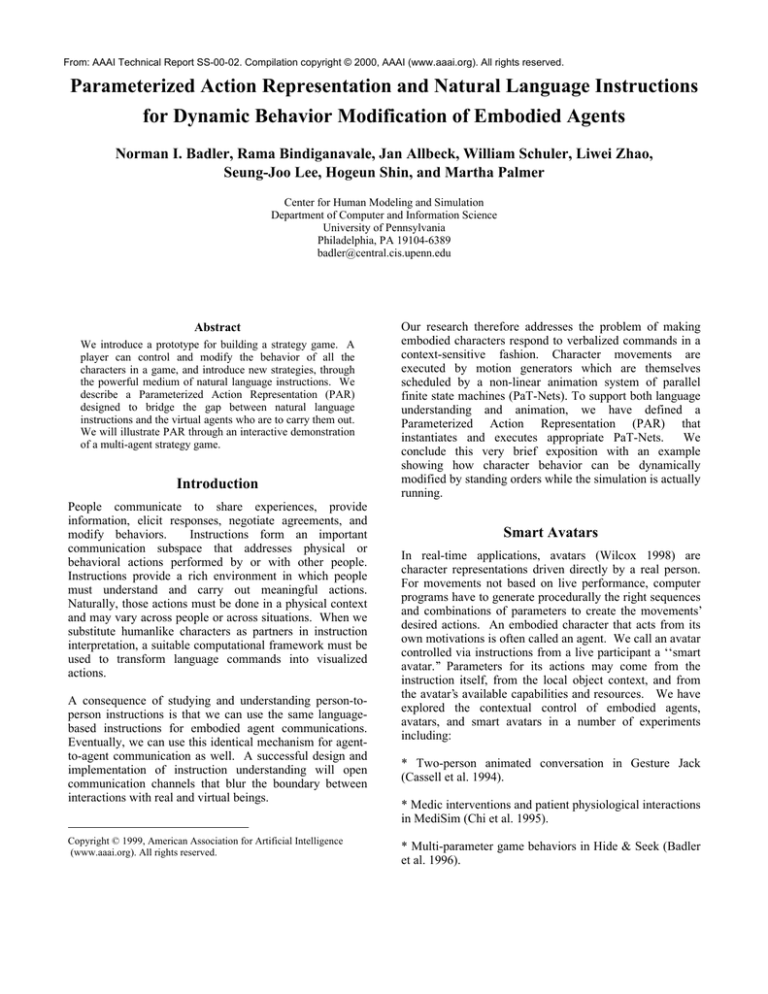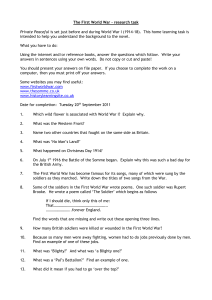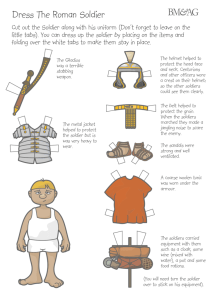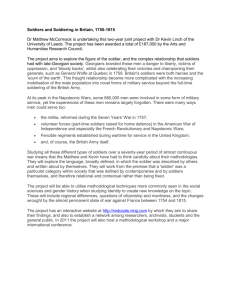
From: AAAI Technical Report SS-00-02. Compilation copyright © 2000, AAAI (www.aaai.org). All rights reserved.
Parameterized Action Representation and Natural Language Instructions
for Dynamic Behavior Modification of Embodied Agents
Norman I. Badler, Rama Bindiganavale, Jan Allbeck, William Schuler, Liwei Zhao,
Seung-Joo Lee, Hogeun Shin, and Martha Palmer
Center for Human Modeling and Simulation
Department of Computer and Information Science
University of Pennsylvania
Philadelphia, PA 19104-6389
badler@central.cis.upenn.edu
Abstract
We introduce a prototype for building a strategy game. A
player can control and modify the behavior of all the
characters in a game, and introduce new strategies, through
the powerful medium of natural language instructions. We
describe a Parameterized Action Representation (PAR)
designed to bridge the gap between natural language
instructions and the virtual agents who are to carry them out.
We will illustrate PAR through an interactive demonstration
of a multi-agent strategy game.
Introduction
People communicate to share experiences, provide
information, elicit responses, negotiate agreements, and
modify behaviors.
Instructions form an important
communication subspace that addresses physical or
behavioral actions performed by or with other people.
Instructions provide a rich environment in which people
must understand and carry out meaningful actions.
Naturally, those actions must be done in a physical context
and may vary across people or across situations. When we
substitute humanlike characters as partners in instruction
interpretation, a suitable computational framework must be
used to transform language commands into visualized
actions.
A consequence of studying and understanding person-toperson instructions is that we can use the same languagebased instructions for embodied agent communications.
Eventually, we can use this identical mechanism for agentto-agent communication as well. A successful design and
implementation of instruction understanding will open
communication channels that blur the boundary between
interactions with real and virtual beings.
Copyright © 1999, American Association for Artificial Intelligence
(www.aaai.org). All rights reserved.
Our research therefore addresses the problem of making
embodied characters respond to verbalized commands in a
context-sensitive fashion. Character movements are
executed by motion generators which are themselves
scheduled by a non-linear animation system of parallel
finite state machines (PaT-Nets). To support both language
understanding and animation, we have defined a
Parameterized Action Representation (PAR) that
instantiates and executes appropriate PaT-Nets.
We
conclude this very brief exposition with an example
showing how character behavior can be dynamically
modified by standing orders while the simulation is actually
running.
Smart Avatars
In real-time applications, avatars (Wilcox 1998) are
character representations driven directly by a real person.
For movements not based on live performance, computer
programs have to generate procedurally the right sequences
and combinations of parameters to create the movements’
desired actions. An embodied character that acts from its
own motivations is often called an agent. We call an avatar
controlled via instructions from a live participant a ‘‘smart
avatar.’’ Parameters for its actions may come from the
instruction itself, from the local object context, and from
the avatar’s available capabilities and resources. We have
explored the contextual control of embodied agents,
avatars, and smart avatars in a number of experiments
including:
* Two-person animated conversation in Gesture Jack
(Cassell et al. 1994).
* Medic interventions and patient physiological interactions
in MediSim (Chi et al. 1995).
* Multi-parameter game behaviors in Hide & Seek (Badler
et al. 1996).
* A real-time animated Jack Presenter (Noma and Badler
1997; Zhao 1998).
* Multi-user Jack-MOO virtual worlds (Shi et al. 1999).
* Virtual environment simulation using parameterized
action representation (Badler, Palmer, and Bindiganavale
1999).
In the last two systems, we began to explore an architecture
for interacting with characters that was solely languagebased in order to explicitly approach a level of interaction
comparable to that between real people. We focused on
instructions for physical action to bound the problem, to
enable interesting applications, and to refine a
representation bridging natural language (NL) and
embodied action.
Levels of Architectural Control
Building a character model that admits control from
sources other than direct animator manipulations requires
an architecture that supports higher-level expressions of
movement. Although layered architectures for autonomous
beings are not new (Brooks 1989; Johnson and Rickel
1997; Zeltzer 1990), we have found that a particular set of
architectural levels seems to provide efficient localization
of control for both graphics and language requirements.
Our multi-level architecture is grounded in typical
graphical models, articulation structures, and motion
generators. The higher architectural levels organize these
skills with parallel automata, use a conceptual
representation to describe the actions a character can
perform, and finally create links between natural language
and action animation.
Parallel Transition Networks
Our parallel programming model is called Parallel
Transition Networks, or PaT-Nets (Badler, Phillips, and
Webber 1993).
Other character animation systems,
including Motion Factory’s Motivate and New York
University’s Improv (Perlin and Goldberg 1996), have
adopted similar paradigms with alternative syntactic
structures. In general, network nodes represent processes.
Arcs connect the nodes and contain predicates, conditions,
rules, and other functions that trigger transitions to other
process nodes. Synchronization across processes or
networks is made possible through message passing or
global variable blackboards to let one process know the
state of another process.
PaT-Nets are effective programming tools but must be
hand-coded in C++. No matter what artificial language we
invent to describe human actions, it is not likely to
represent exactly the way people conceptualize a particular
situation. If we want human-like control, then we need a
higher-level representation to capture additional
information, parameters, and aspects of human action. We
create such representations by incorporating natural
language semantics into a Parameterized Action
Representation.
Language-Based Control
Even with powerful motion generators and PaT-Nets to
invoke them, we still have to provide effective user
interfaces to control, manipulate, and animate characters.
We would also like to be able to instruct these characters
while a simulation is running, so a user could dynamically
refine an avatar’s behavior or react to simulated stimuli
without having to undertake a lengthy off-line
programming session.
One promising and relatively unexplored option for giving
run-time instructions to characters is a natural language
interface. After all, instructions for real people are given in
natural language, augmented with graphical diagrams, and,
occasionally, live or previously generated animations.
Recipes,
instruction
manuals,
and
interpersonal
conversations all use natural language as a medium for
conveying information about processes and actions (Badler
et al. 1990; Badler, Phillips, and Webber 1993; Webber et
al. 1995; Huffman and Laird, 1995). A natural language
interface should be powerful enough to express conditional
instructions and hypothetical situations, and it should be
simple enough to use in a real-time application with little or
no substantial formal user training.
Although the problem of parsing unrestricted text is by no
means solved, broad-coverage grammars do exist that can
account for many of the most common natural language
constructions (Xtag, 1995). If we assume our interface will
only be used for giving instructions grounded in an
established virtual environment, we can ignore many of the
problems of unknown words and syntactic constructions
that make unrestricted text so hard to parse. This limited
domain should also constrain syntactic and semantic
ambiguity enough for existing statistical disambiguation
techniques to produce reliable interpretations.
We are not advocating that animators throw away their
graphical tools, only that natural language offers a
communication medium we all know and can use to
efficiently formulate run-time instructions for virtual
characters. Some aspects of some actions are certainly
difficult to express in natural language (such as precise
locations and orientations of objects), but the availability of
a language interpreter can make the user interface more
closely simulate real interpersonal communication. Our
goal is to build smart avatars that understand what we tell
them to do in the same way humans follow instructions.
These smart avatars have to be able to process natural
language instructions into a conceptual representation that
can be used to control their actions. This representation is
what we refer to as a Parameterized Action Representation.
Parameterized Action Representation (PAR)
A PAR (Badler et al. 1997) gives a description of an action.
The PAR (Figure 1) has to specify the agent of the action
as well as any relevant objects and information about path,
location, manner, and purpose for a particular action.
There are linguistic constraints on how this information can
be conveyed by the language; agents and objects tend to be
verb arguments, paths are often prepositional phrases, and
manner and purpose might be in additional clauses (Palmer,
Rosenzweig, and Schuler 1998). A parser and translator
map the components of an instruction into the parameters
or variables of the PAR, which is then linked directly to
PaT-Nets executing the specified movement generators.
Natural Language often describes actions at a high level,
leaving out many of the details that have to be specified for
animation (Narayanan 1997). The PAR bridges the gap
between natural language and animations. More detail on
the PAR and the architecture that executes them may be
found in (Badler, Palmer, and Bindiganavale 1999).
PAR for Virtual Environment Training
The implemented “Virtual Environment for Training” is a
prototype of a game of military strategies, in which a player
controls a group of soldiers. Each soldier in the game has a
different role to play, can make individual decisions, and
react to changes in environment and the actions of others.
Each civilian in the game can have a different personality
and hence react differently to similar situations. The player
monitors all the soldiers’ actions and gives them explicit
natural language instructions to modify their behaviors and
actions, thus changing the strategy of the game.
The interactive demonstration scenario is a military
checkpoint, with three soldiers whose job is to apprehend
suspected spies. A separate agent process controls each of
the soldiers. A process simulator (also an agent process)
generates and controls vehicles, and operates traffic lights.
As each vehicle approaches the checkpoint, one of the
soldiers checks each civilian male driver's identification. If
there is a match, the soldier is supposed to draw his weapon
and take the driver into custody. All others are allowed to
pass through the checkpoint.
Figure 1. PAR Attributes
During this process, the soldiers may make strategic errors
which cause them to get shot by enemy spies. In order to
refine the checkpoint strategy, the player must give the
checkpoint soldiers new standing orders so these errors
won’t happen again.
Standing orders are instructions from the player to correct
the soldiers’ errors. In the first situation, the soldier does
not take cover while drawing his weapon at the driver and
so gets shot by him. To correct this, the player gives the
following standing order to that soldier: “When you draw
your weapon at the driver, take cover from the driver
behind your drum.” This standing order is immediately
parsed and stored as a Python script (Lutz 1996) in the ruletable. So, in the next trial of the simulation, as soon as the
soldier draws his weapon, the standing order (now rule)
forces him to take cover behind his drum correctly.
The player also notices that when one of the soldiers draws
his weapon, the other two soldiers remain standing still,
which leaves them vulnerable, so the standing order is
given: “If Soldier1 draws his weapon at the driver, draw
your weapon at the driver and take cover from the driver
behind your drum.” The command “take cover” takes two
oblique arguments - the potential threat (in this case, the
driver), and the desired cover (the steel drum). When this
PAR is executed, the soldier moves to a place where the
drum intersects the path between himself and the driver.
But since the “take cover” action is parameterized at this
high level, the soldier could be instructed to take cover
from virtually any object (say, from one of his
companions), behind any other object (say, behind the spy's
car), and the simulation would accommodate it.
After the first spy is taken away, the scenario continues
until a second suspect enters the checkpoint. This time,
however, the suspect draws a gun as soon as the first
soldier asks him for his identification, and shoots the
soldier before he can react. Observing that the soldiers on
the passenger side of the car could have seen the driver
reach for the gun, the user gives two additional standing
orders for soldiers 2 and 3:
* “When there is a driver, watch the driver.”
* “If the driver reaches for a gun, warn Soldier1.”
Once again the simulation is replayed and whenever there
is a driver in the car at the checkpoint, the above standing
orders force soldiers 2 and 3 to watch the driver.
Moreover, when the driver reaches for his gun, the rules
force those soldiers to warn the first soldier, before the
driver can fire. So, the first soldier has time to draw his
own weapon and take cover. Since all the previous orders
are still in the system's memory, soldiers 2 and 3 also draw
their weapons at the driver as soon as they see soldier 1 do
so, and all three still take cover when they draw their
weapons. The driver, outnumbered, quickly surrenders,
and the soldiers successfully complete the exercise.
The “watch” action is classified as a preemptive action and
so its PAR has a lower priority. This means that whenever
the soldiers need to execute other actions, their agent
processes will preempt the “watch” from their queues and
execute the other actions. But after the other actions have
been completed, if there is still a driver at the checkpoint,
the rule resulting from the standing order “When there is a
driver, watch the driver” will again force the soldiers to
watch the driver. This results in a completely naturallooking correct scenario where the soldiers are always
cautiously watching the driver. If they are interrupted and
forced to do something else, they quickly finish that task
and resume watching.
Discussion
The PAR architecture and its implementation is intended to
provide a test bed for real-time smart avatars and agents
who work, communicate, and manipulate objects in a
synthetic 3-D world. Our goal is to make interaction with
these embodied characters the same as with live
individuals. We have focused on language as the medium
for communicating instructions and finite state machines as
the controllers for agent or object movements.
The structure described here is the basis for a new kind of
dictionary we call an Actionary™. A dictionary uses
words to define words. Sometimes it grounds concepts in
pictures and perhaps even sounds and video clips. But
these are canned and not parameterized - flexible and
adaptable to new situations the way that words function in
actual usage. In contrast, the Actionary uses PAR and its
consequent animations to ground action terms. It may be
viewed as a 3-D (spatialized) environment for animating
situated actions expressed in linguistic terms. The actions
are animated to show the meaning in context, that is,
relative to a given 3-D environment and individual agents.
Additionally, the Actionary enables low-bandwidth
communication of instructions across a distributed multiperson simulation system since only the high-level NL
commands need to be transmitted rather than low-level
character movement data.
An instruction understanding system, based on natural
language inputs, an Actionary translation, and an embodied
agent could provide a non-programming interface between
real and virtual people. We can describe tasks for others
and see them carried out, whether they are real or virtual
participants. Thus the door is opening to novel applications
for embodied agents in games, job training, team
coordination, manufacturing and maintenance, education,
and emergency drills. As the Actionary grows, new
applications should become ever easier to generate. And
just as our human experience lets real people take on new
tasks, so too should embodied characters be adaptable to
new environments, new behaviors, and new instructions.
Chi, D., B. Webber, J. Clarke, and N. Badler. Casualty
modeling for real-time medical training. Presence
5(4):359--366.
Acknowledgments
Huffman, S. and J.E. Laird, 1995. Flexibly Instructable
Agents. Journal of Artificial Intelligence Research 3:
271—324.
This research is partially supported by U.S. Air Force
F41624-97-D-5002, Office of Naval Research K-555043/3916-1552793, DURIP N0001497-1-0396, and
AASERTs N00014-97-1-0603 and N0014-97-1-0605,
DARPA SB-MDA-97- 2951001, NSF IRI95-04372, SBR8900230, and IIS-9900297, Army Research Office
ASSERT DAA 655-981-0147, NASA NRA NAG 5-3990,
and Engineering Animation Inc.
References
Badler, N., M. Palmer, and R. Bindiganavale. 1999.
Animation control for real-time virtual humans.
Communications of the ACM 42(7):65--73.
Badler, N., C. Phillips, and B. Webber. 1993. Simulating
humans: Computer graphics animation and control. New
York: Oxford University Press.
Badler, N., B. Webber, W. Becket, C. Geib, M. Moore, C.
Pelachaud, B. Reich, and M. Stone. 1996. Planning for
animation. In N. Magnenat-Thalmann and D. Thalmann,
eds., Interactive Computer Animation, 235-262. New York:
Prentice-Hall.
Badler, N., B. Webber, J. Kalita, and J. Esakov. 1990.
Animation from instructions. In N. Badler, B. Barsky, and
D. Zeltzer, eds., Making them move: Mechanics, control,
and animation of articulated figures, 51--93.
San
Francisco: Morgan-Kaufmann.
Badler, N., B. Webber, M. Palmer, T. Noma, M. Stone, J.
Rosenzweig, S. Chopra, K. Stanley, J. Bourne, and B. Di
Eugenio. 1997. Final report to Air Force HRGA regarding
feasibility of natural language text generation from task
networks for use in automatic generation of Technical
Orders from DEPTH simulations. Technical report, CIS,
University of Pennsylvania.
Brooks, R., A robot that walks: Emergent behaviors from a
carefully evolved network. Neural Computation 1(2):253-262.
Cassell, J., C. Pelachaud, N. Badler, M. Steedman, B.
Achorn, W. Becket, B. Douville, S. Prevost, and M. Stone.
1994. Animated conversation: Rule-based generation of
facial expression, gesture and spoken intonation for
multiple conversational agents. In Computer Graphics,
413--420. New York: ACM SIGGRAPH.
Johnson, W.L., and J. Rickel. 1997. Steve: An animated
pedagogical agent for procedural training in virtual
environments. SIGART Bulletin 8(1--4):16--21.
Lutz, M.1996. Programming Python. Sebastapol: O'Reilly.
Narayanan, S. 1997. Talking the talk is like walking the
walk. In Proceedings of the 19th Annual Conference of the
Cognitive Science Society, 000--000. Palo Alto, Calif.
Noma, T., and N. Badler. 1997. A virtual human presenter.
In IJCAI ’97 Workshop on Animated Interface Agents,
Nagoya, Japan.
Palmer, M., J. Rosenzweig, and W. Schuler. 1998.
Capturing motion verb generalizations with synchronous
tag. In P. St. Dizier, ed., Predicative forms in NLP. Text,
speech, and language technology series, (250--277).
Dordrecht, The Netherlands: Muwer Press.
Perlin, K., and A. Goldberg. 1996. Improv: A system for
scripting interactive actors in virtual worlds. In Computer
Graphics, 205-216. New York: ACM, SIGGRAPH.
Shi, J.,T. J. Smith, J. Granieri, and N. Badler. 1999. Smart
avatars in JackMOO. In Proceedings of IEEE Virtual
Reality, 156--163. Los Alamitos: IEEE Computer Society.
Webber, B.,N. Badler,B. Di Eugenio, C. Geib, L. Levison,
and M. Moore. 1995. Instructions, intentions and
expectations. Artificial Intelligence Journal 73:253--269.
Wilcox, S. K. 1998. Web developer’s guide to 3D avatars.
New York: Wiley.
XTAG Research Group, 1995. A lexicalized tree adjoining
grammar for English. Technical Report, University of
Pennsylvania.
Zeltzer, D. 1990. Task-level graphical simulation:
Abstraction, representation, and control. In N. Badler, B.
Barsky, and D. Zeltzer, eds., Making them move:
Mechanics, control, and animation of articulated figures,
3--33. San Francisco: Morgan-Kaufmann.
Zhao, L., and N. Badler. 1998. Gesticulation behaviors for
virtual humans. In Proceedings of Pacific Graphics, 161-168. Los Alamitos: IEEE Computer Society.




